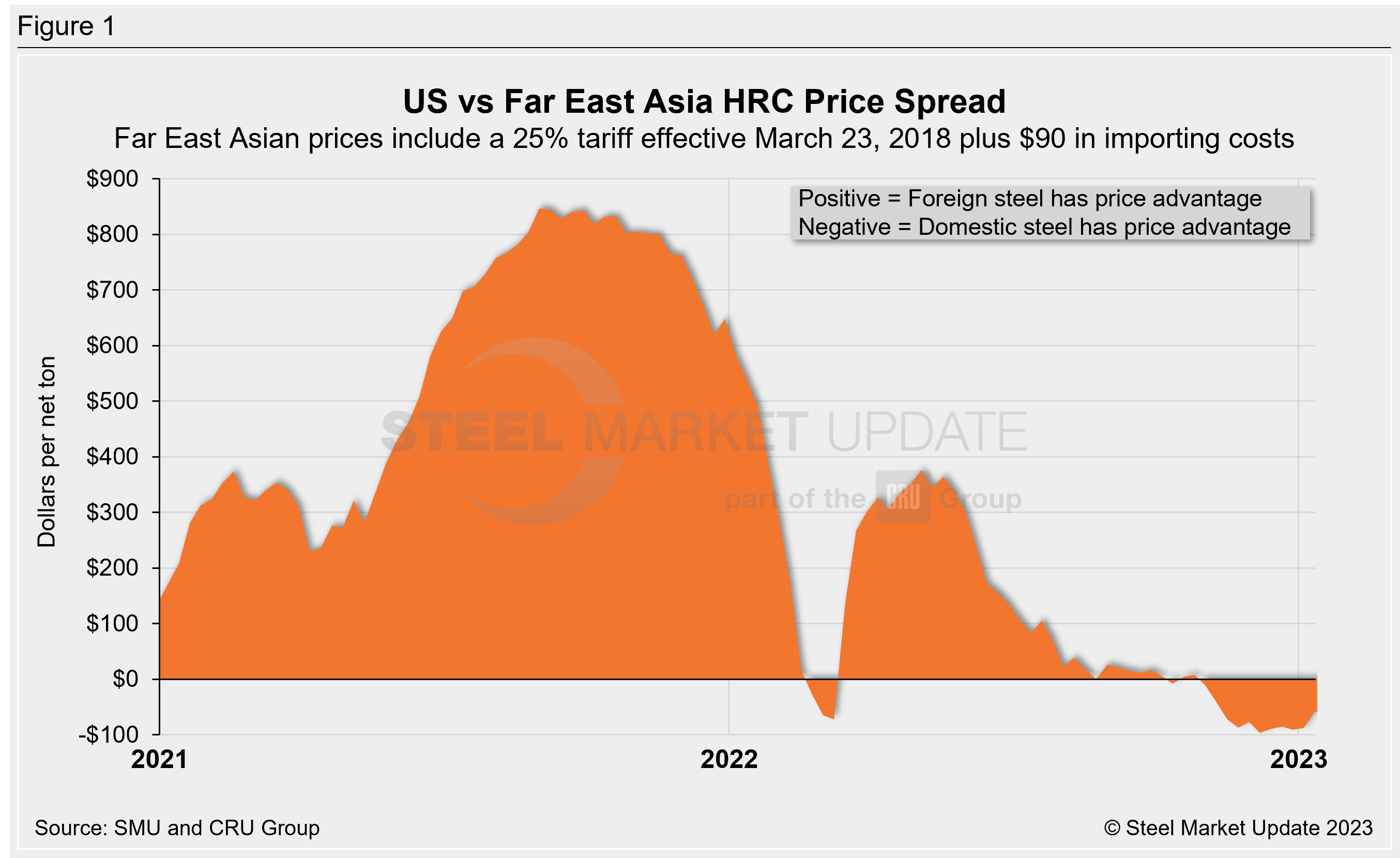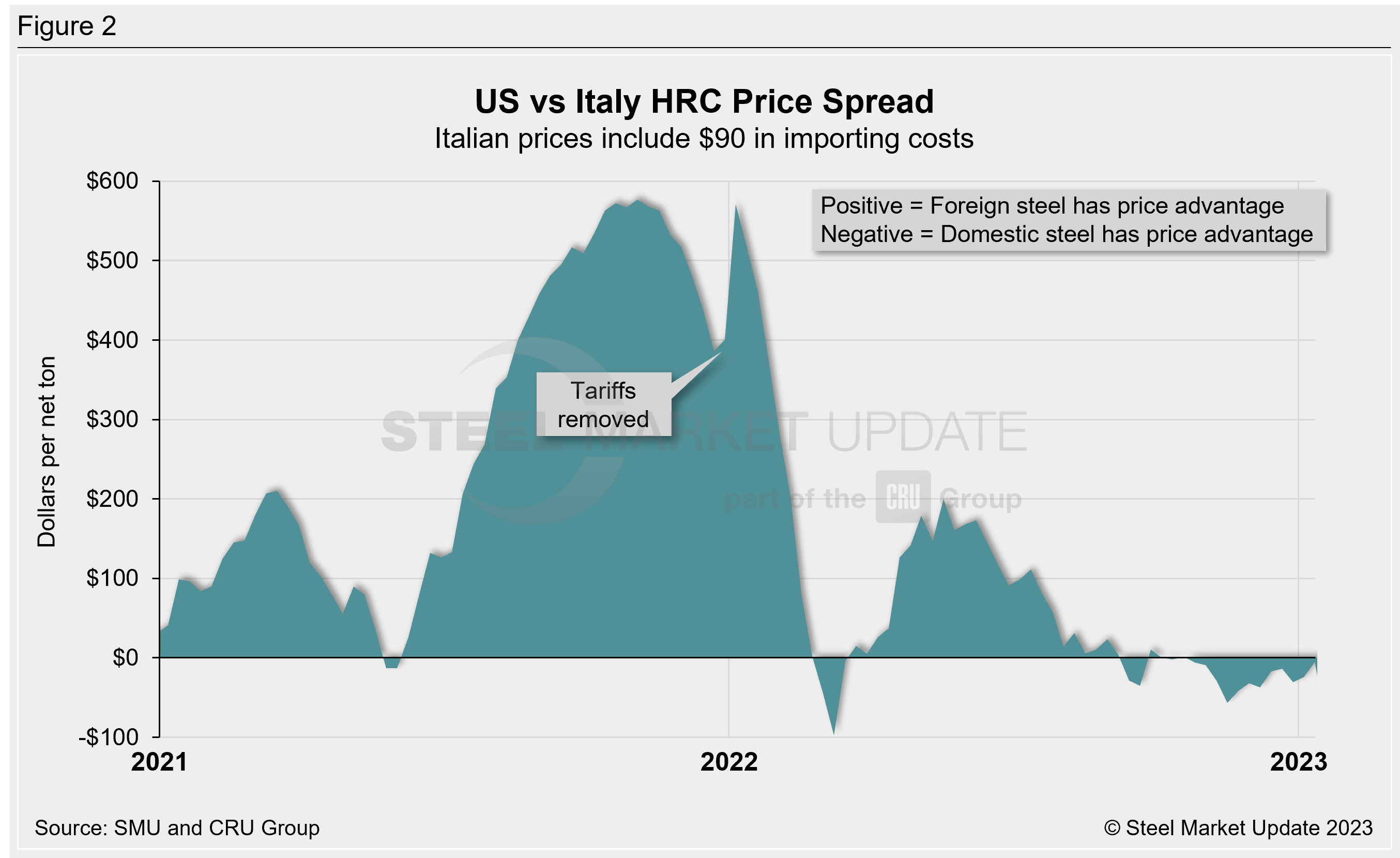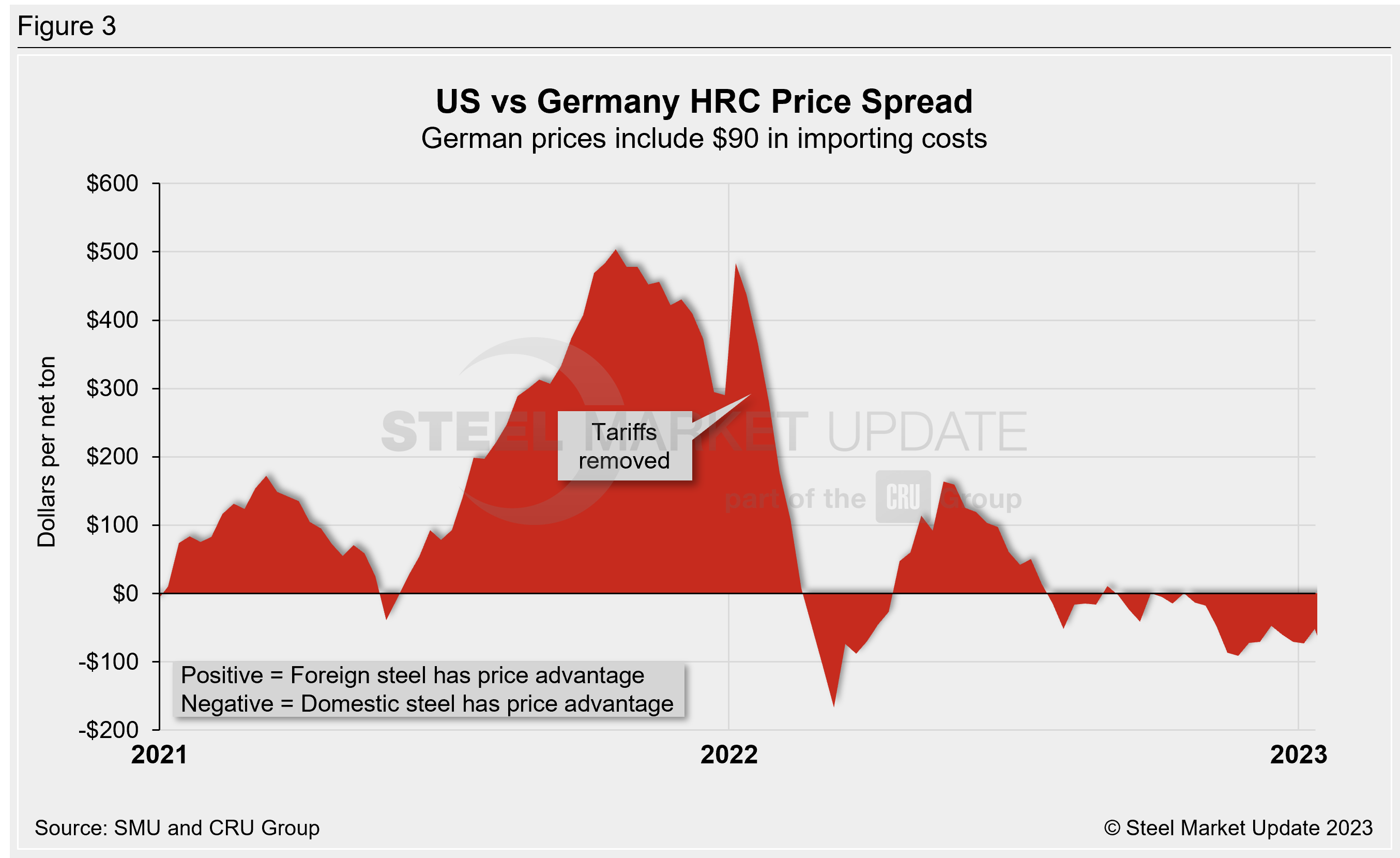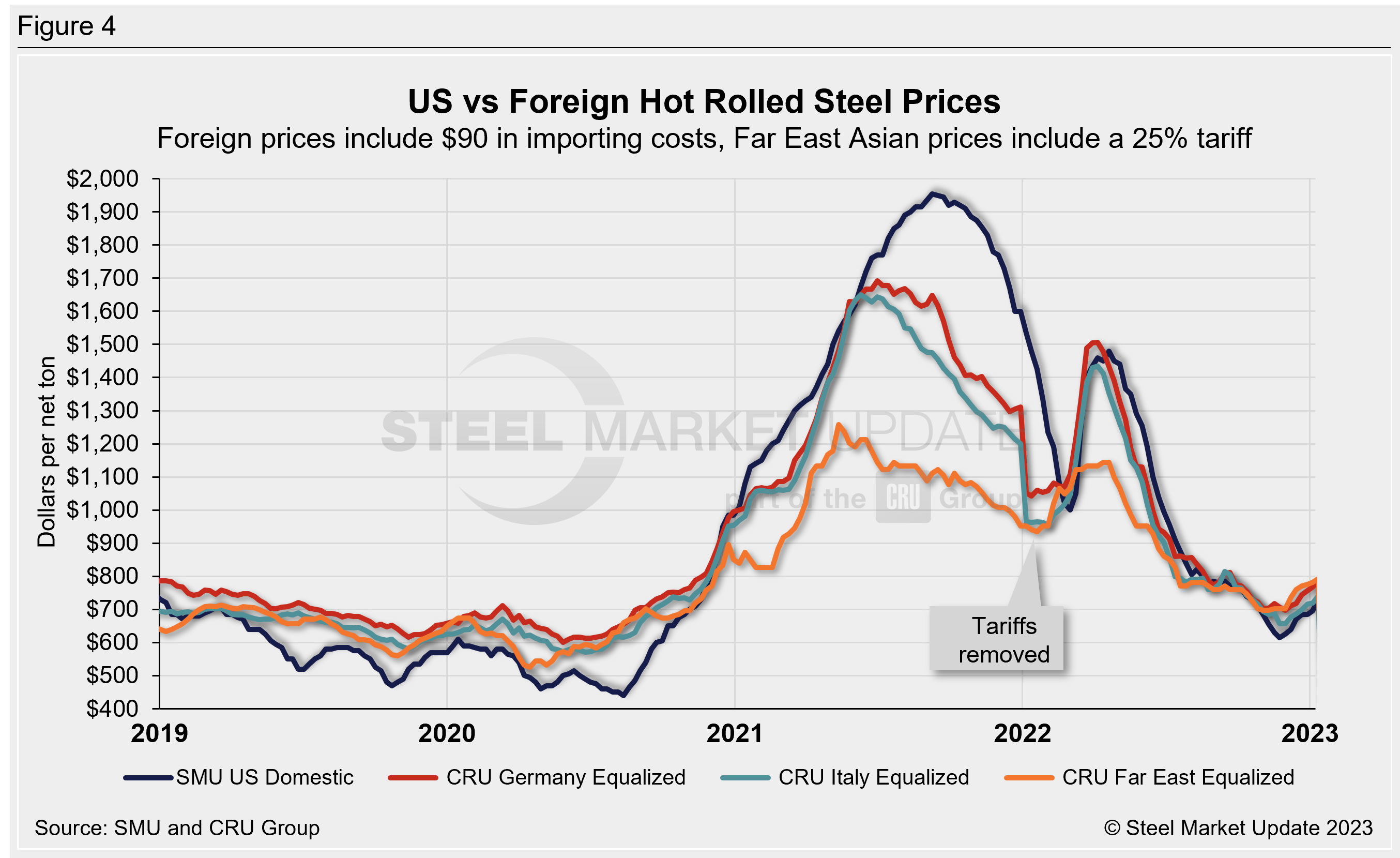SMU Community Chat
Domestic HRC Competitive Advantage Over Import Prices Slips
Written by David Schollaert
January 12, 2023
Domestic hot-rolled coil (HRC) continues to hold a competitive price advantage over imported steel, though it has declined over the past couple of weeks, according to Steel Market Update’s latest foreign vs. domestic price analysis.
![]() US HRC is approximately just 1–8% cheaper than foreign prices this week, after consideration of freight costs, trader margins, and any applicable tariffs. This is the 11th consecutive week US prices have been cheaper than foreign prices for all three regions we follow. HRC prices for all regions increased week over week, with the average spread shrinking from $61 per ton last week to $38 per ton this week.
US HRC is approximately just 1–8% cheaper than foreign prices this week, after consideration of freight costs, trader margins, and any applicable tariffs. This is the 11th consecutive week US prices have been cheaper than foreign prices for all three regions we follow. HRC prices for all regions increased week over week, with the average spread shrinking from $61 per ton last week to $38 per ton this week.
SMU uses the following calculation to identify the theoretical spread between foreign HRC prices (delivered to US ports) and domestic HRC prices (FOB domestic mills): Our analysis compares the SMU US HRC weekly index to the CRU HRC weekly indices for Germany, Italy, and Far East Asian ports. This is only a theoretical calculation because costs to import can vary greatly and often fluctuate, which influences the true market spread.
In consideration of freight costs, handling, and trader margin, we add $90 per ton to all foreign prices to provide an approximate CIF US ports price that can be compared against the SMU domestic HRC price. Buyers should use our $90-per-ton figure as a benchmark, adjusting it as necessary based on their own shipping and handling costs. If you have experience importing foreign steel and want to share your thoughts on these costs, we welcome your insight and comments: David@SteelMarketUpdate.com.
Far East Asian Hot-Rolled Coil (East and Southeast Ports)
As of Wednesday, Jan. 11, the CRU Far East Asian HRC price increased $9 per ton week on week (WoW) to $562 per net ton ($620 per metric ton), up $27 from levels one month prior. Adding a 25% tariff, and $90 per ton in estimated import costs, the delivered price of Far East Asian HRC to the US is $793 per ton. The latest SMU hot-rolled average is $735 per ton, up $40 from our previous price update, and up $65 compared to our price one month ago.
Therefore, US-produced HRC is now $58 per ton cheaper than steel imported from Far East Asia. This is down from a spread of $87 per ton one week prior. One month ago we saw a spread of $89 per ton, the second-largest price appeal that domestic HRC has had over Far East Asian HRC since September 2020. Prior to October, Far East Asian prices had held the advantage since mid-March (the differential peaked at $375 per ton in May). The widest price advantage recorded for Far East Asian prices was nearly 16 months ago, at $847 per ton in September 2021.

Italian Hot-Rolled Coil
Italian HRC prices increased $21 per ton WoW to $650 per net ton ($717 per metric ton) this week, and $54 per ton higher month on month (MoM). After adding import costs, the delivered price of Italian HRC is approximately $740 per ton.
Domestic HRC is now theoretically just $5 per ton cheaper than imported Italian HRC, down from a spread of $24 per ton last week. One month ago we saw a spread of $17 per ton, favoring domestic prices. In mid-November we saw a spread of $57 per ton, the largest margin in favor of US prices recorded since last March. Domestic steel has held this price advantage since late October. Before the removal of the 25% Section 232 tariff, the spread just 14 months reached $577 per ton in November, the largest in SMU’s data history.

German Hot-Rolled Coil
CRU’s latest German HRC price increased $19 per ton WoW to $697 per net ton ($768 per metric ton), up $70 per ton MoM. After adding import costs, the delivered price of German HRC is approximately $787 per ton.
Accordingly, domestic HRC is now theoretically $52 per ton cheaper than imported German HRC, down from a spread of $73 per ton one week prior. Four weeks ago, prices between these regions were $47 per ton apart (with US prices holding the advantage). Domestic HRC has held this price advantage for all but three weeks since late July. German HRC held the price advantage for the three months prior to that, having reached a 2022 high of $164 per ton in May. Prior to the removal of the 25% tariff, the October 2021 spread of $504 per ton was the widest in SMU’s data history.

Figure 4 compares all four price indices and highlights the effective date of the tariffs. Foreign prices are referred to as “equalized,” meaning they have been adjusted to include importing costs (and tariffs in some cases) for a like-for-like comparison against the US price.

Notes: Freight is an important part of the final determination on whether to import foreign steel or buy from a domestic mill supplier. Domestic prices are referenced as FOB the producing mill, while foreign prices are CIF the port (Houston, NOLA, Savannah, Los Angeles, Camden, etc.). Inland freight, from either a domestic mill or from the port, can dramatically impact the competitiveness of both domestic and foreign steel. When considering lead times, a buyer must take into consideration the momentum of pricing both domestically and in the world markets. In most circumstances, domestic steel will deliver faster than foreign steel ordered on the same day.
Effective Jan. 1, 2022, the traditional Section 232 tariff no longer applies to most imports from the European Union. it has been replaced by a tariff rate quota (TRQ). Therefore, the German and Italian price comparisons in this analysis no longer include a 25% tariff. SMU still includes the 25% Section 232 tariff on foreign prices from other countries. We do not include any antidumping (AD) or countervailing duties (CVD) in this analysis.
By David Schollaert, David@SteelMarketUpdate.com

David Schollaert
Read more from David SchollaertLatest in SMU Community Chat

Join SMU on April 30 for a Community Chat with Bilstein Cold Rolled Steel CEO Brent Wilson
Bilstein Cold Rolled Steel LLC CEO Brent Wilson will be the featured speaker on the next SMU Community Chat webinar on Wednesday, April 30, at 11 am ET. You can register here. Reminder: The live webinar is free to attend. A recording will be available only to SMU subscribers. About Bilstein and Wilson Bilstein Cold […]

Join us for the April 9 Community Chat with Algoma Steel CEO Michael Garcia
During the chat, we’ll discuss trends in the North American sheet and plate markets, as well as the unique aspects of the Canadian market. We’ll talk all thing tariffs — and the timing couldn’t be better in the wake of Liberation Day on April 2.

SMU Community Chat: Alan Price unpacks latest in rapidly shifting tariff terrain
International trade attorney Alan Price sat down with SMU to unpack the latest developments in Trump’s tariff merry-go-round.

Join SMU for a Community Chat on March 13 With Wiley Trade Attorney Alan Price
Wonder what the fallout from all the Trump tariffs might be? A manufacturing renaissance? A post-WWII order in ashes? Or something a little more down the middle? Then register for our next Community Chat on Thursday, March 13 at 11 am ET. Yes, you read that correctly, SMU is shattering precedent by holding a Community Chat on a day that is not Wednesday. Our featured speaker will be Alan Price, a leading trade attorney at Wiley and someone whose columns you read regularly in SMU.

SMU Community Chat: CRU’s Josh Spoores looks out over the Trump 2.0 battlefield
SMU Community Chat with CRU's Josh Spoores.
